Positive Transference
David Cronenberg will be the subject of a complete retrospective at the Museum of the Moving Image starting in January 2012. We are kicking off our Cronenberg coverage at Moving Image Source with Miriam Bale's interview with the filmmaker on his new film, A Dangerous Method, currently in theaters.
With A Dangerous Method, an elegant distillation of the birth of psychoanalysis into a five-character drama about Freud and Jung, David Cronenberg returns to the territory of his first film, Transfer, a seven-minute short about a psychiatrist and his patient. Though the perfectly recreated turn-of-the-century drawing rooms seem to have little in common with the slimy special effects earlier in his career, Cronenberg is again taking the grammar of a popular genre (horror before and glossy European-biopic here) and using it to create an intellectual comedy (as he claims all his films are) about bodies that think.
This film feels more overtly feminist than any of your previous films.
Well, I think the strength of that comes from its not being political. I mean that there is no political agenda: not feminist, not Jungian, not Freudian. It was about presenting the characters as they were, saying what they said, the reality of their relationships, the reality of the era. Which was a very repressive era when it came to women. It was that sort of Victorian period where you placed women on a pedestal, but that's how you enchained them. If you're worshipping women, it sounds like you like women. But of course goddesses are not supposed to be sexual and they're not supposed to be physical. Even in the movie, Freud says, "Oh my need to revere women."
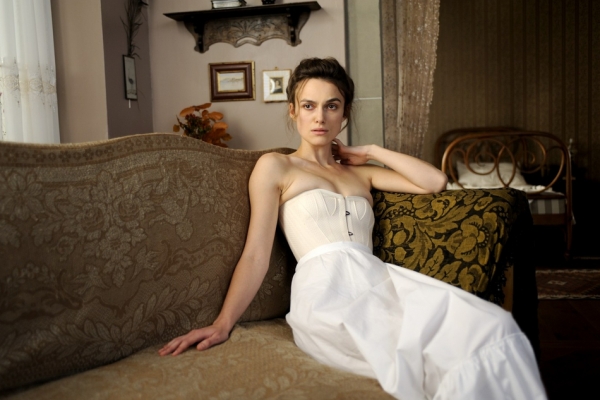
Keira Knightley in A Dangerous Method
In that fleeting moment...
Yes. And it goes by, and people don't mention it. But, in fact, this was absolutely part of the convention of his time, that trope that people would revere women as objects of worship. But that really denies the reality of what a woman is, of what a human is.
It was obviously a very intended moment, that moment of transition where you go from Freud speaking of his need to revere women to the image of Jung spanking a woman.
Well, you might think that spanking women is more realistic. You can see in those scenes that we have Jung not exactly enjoying it. It stresses him. He's doing it for her. He's accepting that she has masochistic tendencies that need to work out this sort of masochistic sexuality she has about her dad beating her. And Otto Gross has encouraged him: Why don't you just take her somewhere and thrash her? It's what she wants. Give her what she wants. And of course Jung says, Pleasure is never simple, blah blah blah...
Now we don't have documentary evidence that they ever did that, but I feel that it's very realistic given where he comes from, where she comes from, given Otto Gross's suggestions that Jung did find totally convincing. Ultimately [whether it's true] is irrelevant in terms of the movie; you're talking about the reality of the characters. So I think it's pretty accurate.
So in the film, Freud revering women would not necessarily indicate his sense of equality, you think?
I think, though, that we have to remember that Freud was a very, very self-aware person, and I think there was some wry humor, self-aware humor there. What he's saying is, I'm glad to hear that you, Jung, are the liar and this woman is not lying, she is pure in truth telling. And that satisfies my desire, my need to revere women. And he did write that. But I think that he's aware that it's a conventional trope.
Freud also had a sister-in-law who was a real intellectual partner for him. And he was actually very gracious towards women. I mean that he encouraged the psychoanalytical community to be open towards women, as you see in the film. Unlike many other boys' clubs at the time, psychoanalysis was male-dominated but it wasn't closed to women.
I think Freud also did a lot for the acceptance of women's sexuality. Stefan Zweig is a Viennese writer, and he wrote a book called The World of Yesterday, which is really fantastic. It's a portrait of his life in Vienna, and he knew everyone, including Freud. He wrote, at the time in the turn of the century, Vienna and the Austro-Hungarian Empire had a higher percentage of prostitutes than anyone in the world. This was co-existing with the idealization of womanhood, as pure, innocent, and beautiful, and so on. And he said as the acceptance of woman's sexuality-the reality of it-increased, the number of prostitutes decreased. And he relates that to Freud. Freud was talking about woman's sexuality, woman masturbating, all the things that were totally unspeakable. These were not accepted topics of conversation. So I actually think you could make the case for Freud as a feminist hero as well, because he was not afraid of those things. He insisted on the reality of the human body both male and female. And this is something that had just not been done before.
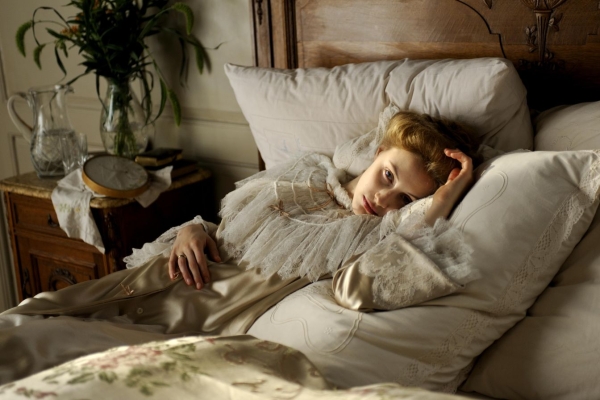
Sarah Gadon in A Dangerous Method
I don't disagree with you, but I do think that's a tricky statement to make, Freud as a feminist hero.
Yeah, well you can make cases either way. I do suggest, though, for anyone who wants to put Freud down, that they do read Freud. You can't just take secondary sources. His writing is incredible. And he's so self-aware; he's aware of the flaws in his own thinking and he's quite willing to admit them, and to analyze them, and to talk about possibilities that turn out to be more true than what he was suggesting was true. He had a pretty expansive mind.
You identify with a lot of the wry humor in Freud?
Absolutely, yeah. I mean, it's not that Jung was humorless, but he was a Swiss-German [laughs], and he was a little less funny than Freud. Freud was very funny. He could use his wit to lacerate his enemies, as well. In Zweig's book he talks about Freud as being masculine, handsome, witty, elegant, charismatic, all of those things that people who only know the old, sick Freud wouldn't recognize. One of the reasons I cast Viggo was to sort of dislocate the stereotype of what Freud was.
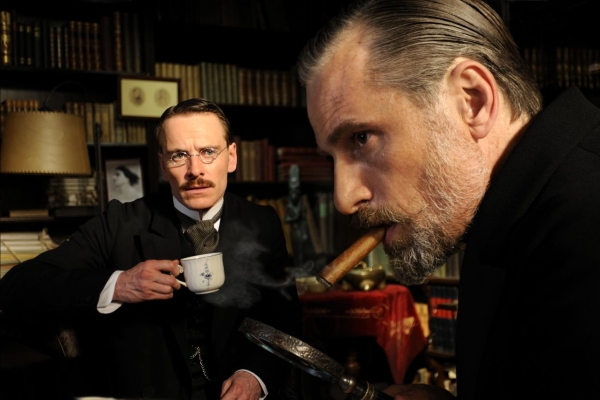
Michael Fassbender and Viggo Mortensen in A Dangerous Method
You know, to continue on this identification with Freud, I think it's not only your most overtly feminist but also maybe your most overtly Jewish film. Except, of course, for that short [At the Suicide of the Last Jew in the World at the last Cinema in the World].
And these were themes that occupied the characters at the time. Because there were many Aryan intellectuals, like Wagner and Nietzsche and Jung, who were obsessed with Jewishness. Trying to figure it out, whether it ended up with them anti-Semitic or not. But the fact of Jewish intellectualism, Jewish philosophy, and Jewish achievement was very threatening and baffling to them. Because Jews had no roots. Jung said it himself: he said Freudian analysis only works for Jews. Now in the context of his time, some of the statements he made wouldn't be considered anti-Semitic, because it was a very anti-Semitic society. Jews at the time could not be in the military, they could not be in the government. Never mind if you were a woman, if you were a Jew and a woman you had even fewer possibilities. So those two things actually go together. This civilization, which considered itself to be the ultimate European society—everything orderly and controlled, everything was evolving beautifully in the Austro-Hungarian empire for 700 years, everything could be distanced, rationality ruled, and the body was constrained and covered up—and here was Freud saying there was a very thin veneer on this civilization of yours. There are things under the surface, tribal barbarism and violence. And of course the First World War was just around the corner. Freud was right. I mean, [WWI] was a crushing disaster for European thought at the time, not just because so many people died of stupidity—it was absolutely a stupid war and unnecessary—but it destroyed their illusions that man was making progress, at least in Europe. That in the seat of civilization we were the ultimate human beings who had evolved to our highest point. That's what they felt. And this is where Freud was saying, not so fast, and being very disruptive and threatening. And that's why he and his methodologies were considered dangerous.
As for that Jewish intellectual history that you were speaking of, do you think humor is a part of that?
Well, Freud's humor to me does feel very Jewish. Someone said to me, He's making Freud look like a Jewish grandfather... Well he was a Jewish grandfather! And he was very aware of that. Like Einstein, he was very aware of his public persona, but he was also very aware of his roots, and what the significance of that was. And the Jewish humor is obviously there in his writing.
Do you think there's some kind of Jewish comedian tradition in your work?
Well, there must be. You know, my parents were liberal, secular, humanists. And I never went to a Jewish school, I never learned Hebrew, I never had a bar mitzvah... So it's not the typical North American Jewish upbringing of the Woody Allen type, let's put it that way.
But I think there must be that in my work. I wasn't lying when I said I think that all my movies are comedies; I think there's humor in all of them. There is a lot of humor on my sets as well, no matter how dark the stuff that we're doing is.
I always think that you, Chantal Akerman, and Frederick Wiseman are more Jewish comedians than people usually notice.
I think that's probably true.
I wanted to ask you about the title. It was originally called The Talking Cure?
Well, in fact it was originally a screenplay for Julia Roberts called Sabina. And when that movie didn't get made, Christopher [Hampton] turned it into The Talking Cure, which is what Freud called his new technique. One of the books that the script was based on was called A Most Dangerous Method, a really terrific book, and that is a quote from William James, the American psychologist. After he heard Freud lecture on the interpretation of dreams he said, this interpretation therapy of Freud's is a most dangerous method. Which is interesting. I felt that it was just a better movie title than Talking Cure. I liked The Talking Cure, but I thought that Freud as someone dangerous was the essence of the movie.
It's nice to be reminded of what we take for granted.
That's just it. People think we're done with Freud but I don't think we're finished with him remotely.
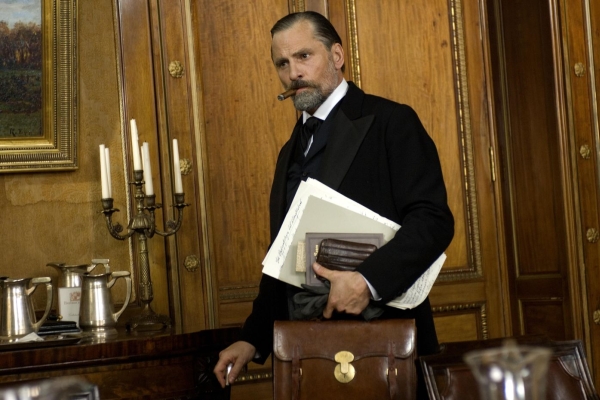
Viggo Mortensen in A Dangerous Method
But The Talking Cure is an interesting title, too, because so much of the film is about the physicality of talking. Is that safe to say?
I think it absolutely is, and of course you see that with Keira [Knightley]'s performance, with the deformity around that.
The hysterical mouth?
The mouth that wants to speak the unspeakable and the body that doesn't want to let it go. The mind that doesn't want to let the body talk. People have a tendency to think of talking as disembodied, that it doesn't have to do with the body. But of course it absolutely has to do with the body. And one of the brilliant things about Freud was to insist on the reality of the human body, including speech.
I was interested in the evolution throughout the film of the different ways you did the standard shot/reverse shot. Early on there's that great shot where Jung is sitting behind her.
Yes, that's right. You know, I don't do storyboards, which is something that young filmmakers often feel they have to do, this sort of comic version of your movie. I'm always baffled by that, because until I'm working with my actors in a room, I have no idea how I'm going to shoot the scene. But with that, it was pretty apparent. He did do that. He didn't know about the couch—as he complained, Freud did not detail his method, so he was trying to figure out his own version of it. He could tell that you don't face the patient; it's not a conversation, therefore you want to remove yourself as much as possible. So he would put the chair behind them, like a train. Once I have that visually, that suggests to me how to shoot the movie.
But yes, then there's the traditional back and forth, which I use when it's appropriate. I try not to bring any stylistic preconceptions to the movie.
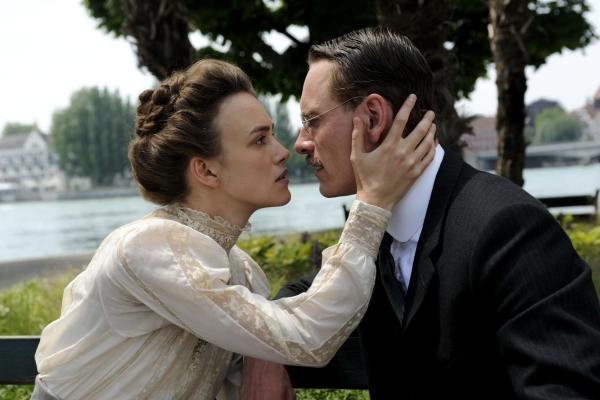
Keira Knightley and Michael Fassbender in A Dangerous Method
You don't avoid those traditional shots, but you just use them very judiciously.
I hate when they move the camera all around. Because the director thinks, If I don't, this is going to be boring, but to me it's just annoying. Unless the camera move is going to reveal something that's significant, why move the camera? You know, you and I are sitting here, talking, and the camera's not moving. We're right here. To me, the thing that you photograph most as a filmmaker is the human face speaking; that is to me the essence of cinema. People call it talking heads and say that it is not cinematic, but to me that's the essence of cinema. When you have a fantastic face saying fantastic words, what could be better? It's incredibly exciting.
It seems like you get closer than the traditional close-up.
In this I used a very wide lens to do the close-ups, which means that you are physically closer with the camera. If I used a 50mm lens, the frame would be filled with your face from much farther back, with the background thrown out of focus, which kind of isolates the face. The audiences can feel that; they might not be aware of it, but they know that the camera is farther away. But if you use a 25mm or 27mm lens, that means that the camera is really close to the face. And I wanted to be that intimate, because they were being really intimate with each other, studying each other. That's why I have Sabina looking in the mirror as she's being beaten, because they were the kind of people who wouldn't have sex without observing themselves having sex, and analyzing it, thinking about how it felt like and what it meant.
So the sex scenes are all kind of framed and from a distance. But in that last scene, when she's looking in the mirror, she seems more satisfied than in the previous scenes.
That's just it. Otto Gross says, Why don't you just give her this simple pleasure, take her somewhere and thrash her within an inch of her life? And Jung says, Well, pleasure is not ever simple. And those things were said. So I'm thinking, Well, Jung is maybe not really enjoying this, he's not really into S&M, but he's doing it for her. He's a little disturbed by it, actually, but he's basically doing it for her.
They're very short, the sex scenes. Why?
It's really two shots, that's it. Of course there's another scene of them making love more conventionally when they first meet, but it's not much. It's always a question of how much is enough, in the therapy sessions or whatever. It's the intensity and delivering the meaning of it; it's always a question of proportion. But for two short shots, it gets a lot of conversation. So you figure it delivered what it needed to deliver.
Do you think that there's an inherent competition between language and the body? Perhaps not, because you just said you think that talking is very physical.
Very physical, yeah. But people can use language to disembody themselves, though, and I think that's what Jung did. We seem to be the only creatures capable of abstraction, and that is all embodied in language. And we can use abstract thought to distance ourselves from bodied reality. I think that Freud insisted on the reality of the body, and Jung represented the flight from the body. He wanted to talk about these vague abstract notions and, to me, that's disembodying. Which is taking you away from what Freud insisted on, which was talking about penises and vaginas—which was considered very shocking at the time, as I said—but those are all body-bound, real things. What Jung did, I think, was to disconnect from that. You can use language to evade the reality of the body; I think that's done all the time. ![]()
LATEST ARTICLES
-20140814-173707-thumb3.jpg)
Fighting Words
by Imogen Sara Smith
posted August 12, 2014

Fighting Words, Part 2
by Imogen Sara Smith
posted August 20, 2014

On the Margins: The Fil…
by Andrew Chan
posted August 12, 2014

Robin Williams: A Sense…
by David Schwartz
posted August 12, 2014
 Positive Transference
Positive Transference
KEYWORDS
David Cronenberg | psychology | Museum of the Moving Image | interview | A Dangerous Method | gender equality | ReligionTHE AUTHOR
Miriam Bale, a critic and film programmer, is the editor of Joan's Digest: A Film Quarterly. She is a regular contributor to The New York Times.
More articles by Miriam BaleAuthor's Website: Joan's Digest: A Film Quarterly

